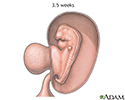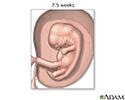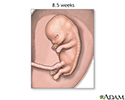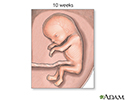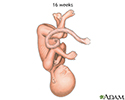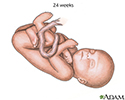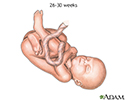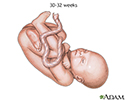Fetal development
Zygote; Blastocyst; Embryo; Fetus
Learn how your baby is conceived and how your baby develops inside the mother's womb.
Information
WEEK BY WEEK CHANGES
Gestation is the period of time between conception and birth when a baby grows and develops inside the mother's womb. Because it's impossible to know exactly when conception occurs, gestational age is measured from the first day of the mother's last menstrual cycle to the current date. It is measured in weeks.
Gestational age
Gestation is the period of time between conception and birth. During this time, the baby grows and develops inside the mother's womb. Gestational ag...
This means that during weeks 1 and 2 of pregnancy, a woman is not yet pregnant. This is when her body is preparing for a baby. A normal gestation lasts anywhere from 37 to 41 weeks.
Week 1 to 2
- The first week of pregnancy starts with the first day of a woman's menstrual period. She is not yet pregnant.
- During the end of the second week, an egg is released from an ovary. This is when you are most likely to conceive if you have unprotected intercourse.
Week 3
- During intercourse, sperm enters the vagina after the man ejaculates. The strongest sperm will travel through the cervix (the opening of the womb, or uterus), and into the fallopian tubes.
- A single sperm and the mother's egg cell meet in the fallopian tube. When the single sperm enters the egg, conception occurs. The combined sperm and egg is called a zygote.
- The zygote contains all of the genetic information (DNA) needed to become a baby. Half the DNA comes from the mother's egg and half from the father's sperm.
- The zygote spends the next few days traveling down the fallopian tube. During this time, it divides to form a ball of cells called a blastocyst.
- A blastocyst is made up of an inner group of cells with an outer shell.
- The inner group of cells will become the embryo. The embryo is what will develop into your baby.
- The outer group of cells will become structures, called membranes, which nourish and protect the embryo.
Week 4
- Once the blastocyst reaches the uterus, it buries itself in the uterine wall.
- At this point in the mother's menstrual cycle, the lining of the uterus is thick with blood and ready to support a baby.
- The blastocyst sticks tightly to the wall of the uterus and receives nourishment from the mother's blood.
Week 5
- Week 5 is the start of the "embryonic period." This is when all the baby's major systems and structures develop.
- The embryo's cells multiply and start to take on specific functions. This is called differentiation.
- Blood cells, kidney cells, and nerve cells all develop.
- The embryo grows rapidly, and the baby's external features begin to form.
- Your baby's brain, spinal cord, and heart begin to develop.
- Baby's gastrointestinal tract starts to form.
- It is during this time in the first trimester that the baby is most at risk for damage from things that may cause birth defects. This includes certain medicines, illegal drug use, heavy alcohol use, infections such as rubella, and other factors.
Weeks 6 to 7
- Arm and leg buds start to grow.
- Your baby's brain forms into 5 different areas. Some cranial nerves are visible.
- Eyes and ears begin to form.
- Tissue grows that will become your baby's spine and other bones.
- Baby's heart continues to grow and now beats at a regular rhythm.
- Blood pumps through the main vessels.
Week 8
- Baby's arms and legs have grown longer.
- Hands and feet begin to form and look like little paddles.
- Your baby's brain continues to grow.
- The lungs start to form.
Week 9
- Nipples and hair follicles form.
- Arms grow and elbows develop.
- Baby's toes can be seen.
- All baby's essential organs have begun to grow.
Week 10
- Your baby's eyelids are more developed and begin to close.
- The outer ears begin to take shape.
- Baby's facial features become more distinct.
- The intestines rotate.
- At the end of the 10th week of pregnancy, your baby is no longer an embryo. It is now a fetus, the stage of development up until birth.
Weeks 11 to 14
- Your baby's eyelids close and will not reopen until about the 28th week.
- Baby's face is well-formed.
- Limbs are long and thin.
- Nails appear on the fingers and toes.
- Genitals appear.
- Baby's liver is making red blood cells.
- The head is very large -- about half of baby's size.
- Your little one can now make a fist.
- Tooth buds appear for the baby teeth.
Weeks 15 to 18
- At this stage, baby's skin is almost transparent.
- Fine hair called lanugo develops on baby's head.
- Muscle tissue and bones keep developing, and bones become harder.
- Baby begins to move and stretch.
- The liver and pancreas produce secretions.
- Your little one now makes sucking motions.
Weeks 19 to 21
- Your baby can hear.
- The baby is more active and continues to move and float around.
- The mother may feel a fluttering in the lower abdomen. This is called quickening, when mom can feel baby's first movements.
- By the end of this time, baby can swallow.
Week 22
- Lanugo hair covers baby's entire body.
- Meconium, baby's first bowel movement, is made in the intestinal tract.
- Eyebrows and lashes appear.
- The baby is more active with increased muscle development.
- The mother can feel the baby moving.
- Baby's heartbeat can be heard with a stethoscope.
- Nails grow to the end of baby's fingers.
Weeks 23 to 25
- Bone marrow begins to make blood cells.
- The lower airways of the baby's lungs develop.
- Your baby begins to store fat.
Week 26
- Eyebrows and eyelashes are well-formed.
- All parts of baby's eyes are developed.
- Your baby may startle in response to loud noises.
- Footprints and fingerprints are forming.
- Air sacs form in baby's lungs, but lungs are still not ready to work outside the womb.
Weeks 27 to 30
- Baby's brain grows rapidly.
- The nervous system is developed enough to control some body functions.
- Your baby's eyelids can open and close.
- The respiratory system, while immature, produces surfactant. This substance helps the air sacs fill with air.
Weeks 31 to 34
- Your baby grows quickly and gains a lot of fat.
- Rhythmic breathing occurs, but baby's lungs are not fully mature.
- Baby's bones are fully developed, but are still soft.
- Your baby's body begins storing iron, calcium, and phosphorus.
Weeks 35 to 37
- Baby weighs about 5 1/2 pounds (2.5 kilograms).
- Your baby keeps gaining weight, but will probably not get much longer.
- The skin is not as wrinkled as fat forms under the skin.
- Baby has definite sleeping patterns.
- Your little one's heart and blood vessels are complete.
- Muscles and bones are fully developed.
Week 38 to 40
- Lanugo is gone except for on the upper arms and shoulders.
- Fingernails may extend beyond fingertips.
- Small breast buds are present on both sexes.
- Head hair is now coarse and thicker.
- In your 40th week of pregnancy, it has been 38 weeks since conception, and your baby could be born any day now.
References
Cunningham FG, Leveno KJ, Bloom SL, et al. Fetal growth and development. In: Cunningham FG, Leveno KL, Bloom SL, et al, eds. Williams Obstetrics . 23rd ed. New York, NY: McGraw-Hill; 2010:chap 4.
Ross MG, Ervin MG, Novak D. Placental and fetal physiology. In: Gabbe SG, Niebyl JR, Simpson JL, eds. Obstetrics: Normal and Problem Pregnancies . 6th ed. Philadelphia, PA: Elsevier Saunders; 2012:chap 2.
-
Fetus at 3.5 weeks - illustration
At 3.5 weeks, the fetus will have formed the heart, begins development of the brain and spinal cord, and starts forming the gastrointestinal tract.
Fetus at 3.5 weeks
illustration
-
Fetus at 7.5 weeks - illustration
At 7.5 weeks, the eyes move forward on the face and eyelids begin to form, the palate is nearing completion and the tongue begins to form, the gastrointestinal tract separates from the genitourinary tract, and all essential organs have begun to form.
Fetus at 7.5 weeks
illustration
-
Fetus at 8.5 weeks - illustration
At 8.5 weeks, the embryo now resembles a human. Facial features continue to develop, the beginnings of external genitalia form, the anal passage opens although the rectal membrane is intact, circulation through the umbilical cord is well developed, and long bones begin to form.
Fetus at 8.5 weeks
illustration
-
Fetus at 10 weeks - illustration
A fetus at 10 weeks of development has fully formed eyelids and well-formed digits and ears.
Fetus at 10 weeks
illustration
-
Fetus at 12 weeks - illustration
A fetus at 12 weeks can make a fist and suck its thumb.
Fetus at 12 weeks
illustration
-
Fetus at 16 weeks - illustration
At week 16, the fetus reaches a length of about 6 inches, makes active movements, and makes sucking motions with the mouth.
Fetus at 16 weeks
illustration
-
Fetus at 24 weeks - illustration
At 24 weeks, the fetus has fully developed eyes, has a hand and startle reflex, is forming footprints and fingerprints, and is forming alveoli in the lungs.
Fetus at 24 weeks
illustration
-
Fetus at 26 to 30 weeks - illustration
At 26 to 30 weeks, a fetus is rapidly developing its brain controls and some body functions. The fetus has eyelids which open and close and has a rapidly developing respiratory system.
Fetus at 26 to 30 weeks
illustration
-
Fetus at 30 to 32 weeks - illustration
At 30 to 32 weeks, a fetus has increased central nervous system control over body functions and rhythmic breathing movements. It is still developing lungs and is partially in control of body temperature.
Fetus at 30 to 32 weeks
illustration
-
Fetus at 3.5 weeks - illustration
At 3.5 weeks, the fetus will have formed the heart, begins development of the brain and spinal cord, and starts forming the gastrointestinal tract.
Fetus at 3.5 weeks
illustration
-
Fetus at 7.5 weeks - illustration
At 7.5 weeks, the eyes move forward on the face and eyelids begin to form, the palate is nearing completion and the tongue begins to form, the gastrointestinal tract separates from the genitourinary tract, and all essential organs have begun to form.
Fetus at 7.5 weeks
illustration
-
Fetus at 8.5 weeks - illustration
At 8.5 weeks, the embryo now resembles a human. Facial features continue to develop, the beginnings of external genitalia form, the anal passage opens although the rectal membrane is intact, circulation through the umbilical cord is well developed, and long bones begin to form.
Fetus at 8.5 weeks
illustration
-
Fetus at 10 weeks - illustration
A fetus at 10 weeks of development has fully formed eyelids and well-formed digits and ears.
Fetus at 10 weeks
illustration
-
Fetus at 12 weeks - illustration
A fetus at 12 weeks can make a fist and suck its thumb.
Fetus at 12 weeks
illustration
-
Fetus at 16 weeks - illustration
At week 16, the fetus reaches a length of about 6 inches, makes active movements, and makes sucking motions with the mouth.
Fetus at 16 weeks
illustration
-
Fetus at 24 weeks - illustration
At 24 weeks, the fetus has fully developed eyes, has a hand and startle reflex, is forming footprints and fingerprints, and is forming alveoli in the lungs.
Fetus at 24 weeks
illustration
-
Fetus at 26 to 30 weeks - illustration
At 26 to 30 weeks, a fetus is rapidly developing its brain controls and some body functions. The fetus has eyelids which open and close and has a rapidly developing respiratory system.
Fetus at 26 to 30 weeks
illustration
-
Fetus at 30 to 32 weeks - illustration
At 30 to 32 weeks, a fetus has increased central nervous system control over body functions and rhythmic breathing movements. It is still developing lungs and is partially in control of body temperature.
Fetus at 30 to 32 weeks
illustration
Review Date: 9/26/2015
Reviewed By: Daniel N. Sacks MD, FACOG, obstetrics & gynecology in private practice, West Palm Beach, FL. Review Provided by VeriMed Healthcare Network. Also reviewed by David Zieve, MD, MHA, Isla Ogilvie, PhD, and the A.D.A.M. Editorial team.

